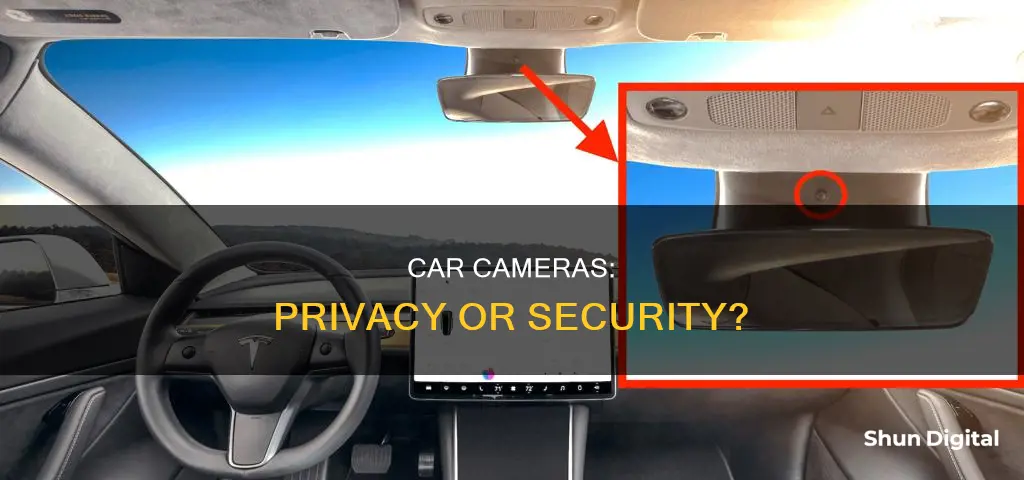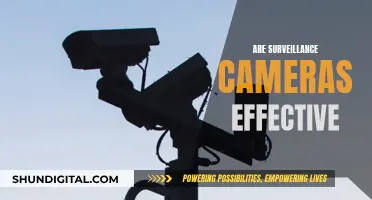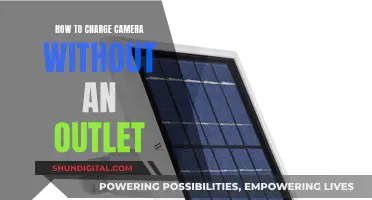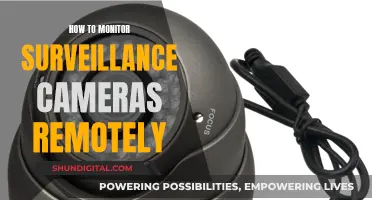
Car cameras are becoming increasingly common, with some vehicles now containing multiple cameras, both inside and outside the car. While some may find the presence of cameras unnerving, they can serve a variety of purposes, from improving safety and security to collecting data for autonomous driving. So, how do you know if your car has a camera, and what is it being used for?
| Characteristics | Values |
|---|---|
| Camera Placement | Inside and outside the car |
| Camera Purpose | Safety, security, data collection |
| Camera Functionality | Blindspot assistance, facial recognition, driver monitoring, accident recording, etc. |
| Data Usage | For future innovations, autonomous driving, digital road maps, etc. |
| Data Privacy | Privacy policies available, opt-out of data sharing, ability to disable cameras |
What You'll Learn
- Car cameras can improve safety by eliminating blind spots
- Cameras can also help cars drive autonomously
- They can be used to monitor the driver and prevent drunk driving
- Cameras can be used to monitor passengers and ensure safety
- They can also be used to record accidents and incidents for insurance claims

Car cameras can improve safety by eliminating blind spots
Car cameras are becoming increasingly common, with some vehicles even offering internal cameras. While some may find this intrusive, car cameras can provide a host of benefits, particularly when it comes to improving safety on the road. One of the most significant advantages of car cameras is their ability to eliminate blind spots, which can be a major cause of accidents, especially when changing lanes or merging.
Car cameras, also known as blind spot cameras or blind spot monitoring systems, provide drivers with a live feed or warning of their blind spots, helping them to be aware of any vehicles or obstacles that may be hidden from their direct line of sight. This is especially useful when driving in areas with heavy traffic, tight spaces, or at night, as it gives drivers an expanded view of their surroundings and reduces the risk of accidents.
Blind spot cameras typically rely on sensors to detect other vehicles in the car's blind spot. These sensors can be mounted on side mirrors, the rear bumper, or built into the door pillars. When a vehicle enters the blind spot, the system activates a warning, which can be in the form of lights or an audible tone. Some more advanced systems even provide a live camera feed on the infotainment screen or instrument cluster, giving drivers a clear view of their blind spots.
Examples of Cars with Blind Spot Cameras
Several car manufacturers have incorporated blind spot cameras into their models, including BMW, Lincoln, Volvo, Honda, Hyundai, and Kia. For instance, the 2019 Kia K900 was designed with 16 cameras and sensors to eliminate blind spots. The 2022 Hyundai Sonata Limited also offers a blind-spot view monitor as a standard feature on its top trim.
Custom Installations
For older cars or those without built-in blind spot cameras, there are aftermarket kits available that can be professionally installed. These kits typically include sensors and warning indicators, such as lights and audio alarms, to alert drivers of vehicles in their blind spots.
In conclusion, car cameras, specifically blind spot cameras, offer a significant improvement in road safety by eliminating blind spots. By providing drivers with an expanded view of their surroundings, these cameras reduce the risk of accidents and increase overall confidence on the road. As technology advances, we can expect to see blind spot cameras become even more prevalent and sophisticated in the years to come.
Camera Batteries: Airplane Safety and Legalities Explored
You may want to see also

Cameras can also help cars drive autonomously
Cameras: The Key to Autonomous Driving?
Cameras are one of the main sensors used in autonomous vehicles (AVs). They are essential for perceiving the environment around the vehicle before path planning and control. While there has been some debate about the optimal sensor suite for self-driving cars, all companies agree on the inclusion of vision sensors or cameras.
Cameras work by landing light emitted from objects onto a photosensitive surface through a lens. This surface, called the image plane, stores the light as an image, which is then converted into electrons, voltage, and finally, a number in a metric unit or pixels.
One of the biggest advantages of cameras is that they are relatively cheap compared to other sensors like radar and lidar, which can cost tens of thousands of dollars. Cameras are also excellent at high-resolution tasks, such as classification, scene understanding, and colour perception, such as traffic light or sign recognition.
However, cameras have their limitations. They struggle in different weather and lighting conditions, even with night vision (NV) or high dynamic range (HDR) capabilities. They also require a lot of processing power to extract information and often offer reliable depth perception only in the near field.
Despite these drawbacks, some companies, like Tesla, are leading the way in developing camera-only self-driving technology. Tesla has created a training data set of one million 10-second videos in various road, weather, and lighting conditions, using data collected from the millions of cars it has sold worldwide. By using neural networks and camera input, Tesla is able to estimate depth, velocity, and acceleration, moving towards a vision-only self-driving system.
Other companies, like Magna, have demonstrated that it is possible to make a car drive itself on the highway using just a single camera embedded in the windshield. While this technology would likely be combined with other sensor systems, it shows that automated driving capabilities can be added to vehicles at a relatively low cost.
While there are differing opinions on whether camera-only technology is the future of self-driving cars, it is clear that cameras play a crucial role in helping vehicles drive autonomously. With continued advancements in camera technology and artificial intelligence, we may see a shift towards more reliance on cameras for autonomous driving.
Avoid Traffic Camera Tickets: Tips for Drivers
You may want to see also

They can be used to monitor the driver and prevent drunk driving
In-car cameras can be used to monitor the driver and prevent drunk driving. Volvo, for example, has implemented in-car cameras to monitor driver behaviour and intervene if the driver appears to be drunk or distracted. The cameras monitor eye movements to gauge distraction or intoxication, and if a driver looks away for a period of time or fails to keep their hands on the steering wheel, a representative from Volvo's assistance centres will call them to check in. If the driver doesn't respond, the car will slow down and stop.
Similarly, researchers at Edith Cowan University are working on technology that will identify drunk drivers by analysing in-car video. The researchers compiled video data of drunk drivers by putting 60 subjects through simulated driving scenarios with three levels of alcohol intoxication. A machine learning system then analysed the video data, and was able to detect levels of intoxication with an overall accuracy of 75%. The researchers believe that this technology could be used not just for in-car camera monitoring systems, but also for smartphone cameras, allowing drivers to check for impairment before getting behind the wheel.
In addition, the $1 trillion infrastructure bill in the US includes a provision that requires automakers to build technology into new cars that can detect if drivers are drunk. While the bill does not specify the type of technology to be used, industry experts believe that companies developing camera-based driver monitoring systems will benefit the most. Camera-based systems are preferred over breath or touch-based approaches because BAC levels can rise within minutes, and camera systems can detect impairment in real-time.
Extending Action Camera Battery Life: Tips and Tricks
You may want to see also

Cameras can be used to monitor passengers and ensure safety
In-car cameras are becoming an increasingly common feature, with some car manufacturers, like Volvo and Subaru, now installing them inside vehicles. These cameras can be used to monitor passengers and ensure safety in several ways.
One of the primary purposes of in-car cameras is to detect drunk or intoxicated drivers and prevent them from driving. These cameras can analyze the driver's face and behaviour to determine if they are fit to drive. This technology helps combat drunk driving and improve road safety.
In-car cameras can also monitor driver awareness and alertness. For example, the Cadillac CT5 compact sedan has a hands-free driving assistant that can navigate highways, but only if the driver stays attentive. The system uses a camera to monitor the driver's awareness and take control if needed.
Additionally, in-car cameras can be used to ensure the safety and protection of the vehicle and its occupants. For instance, Tesla has installed a camera above the rearview mirror to record any incidents that occur when the car is being used for ride-sharing. This allows drivers to check the video if someone messes up their car.
Furthermore, in-car cameras can be used to monitor and improve driving behaviour. For example, the Ring Car Cam records both inside and outside the car and can help restrict bad driving habits. It also has a two-way talk feature that can be used to scare off potential thieves.
While in-car cameras raise privacy concerns, they can be a valuable tool for improving safety, deterring crimes, and providing evidence in the event of accidents or incidents.
Spare Camera Battery: Safe and Easy Transport Tips
You may want to see also

They can also be used to record accidents and incidents for insurance claims
Car cameras can be used to record accidents and incidents for insurance claims. This footage can be used to prove liability and contest claims of negligence. In some cases, insurance companies may use the footage to assert contributory negligence, which can reduce or eliminate the compensation paid out to the claimant.
It is important to note that insurance companies are not the only ones who can use this footage. Drivers can also use video evidence to support their insurance claims and personal injury lawsuits. This evidence can be especially useful in hit-and-run cases, where the driver who caused the accident has fled the scene. In these cases, video footage can help identify the driver who is at fault. Additionally, this footage can be used to prove that an accident occurred the way the claimant remembers, which can be helpful if there are disputes over how the accident happened.
However, obtaining video footage of an accident is not always easy. The process can be tricky and involve legal and bureaucratic hassles. Private individuals and businesses are not required to give up their video footage just because someone asks for it. It is their property, even if the footage shows things that happened on public streets or sidewalks. In some cases, a court order or subpoena may be needed to obtain the footage.
It is also important to act quickly when requesting video footage, as many companies regularly delete their footage, sometimes keeping it for as little as a few days or 72 hours. Additionally, when requesting footage from a private company, it may be necessary to fill out a formal written request and wait several weeks for a response. Obtaining footage from government agencies can also be complicated, as it may be unclear which agency owns the camera and how to request the footage.
Overall, while car cameras can be useful in recording accidents and incidents for insurance claims, obtaining and using this footage can be a complex process. It may be necessary to seek legal assistance to navigate the process successfully.
Surveillance Camera Footage: Identifying Intruders and Trespassers
You may want to see also
Frequently asked questions
Yes, cars can have cameras installed both inside and outside the vehicle.
Cameras can improve vehicle security, safety, and convenience. They can help with parking, provide blindspot assistance, and even help the car drive in the case of semi-autonomous vehicles.
Cameras can be used to spy on you and collect your data. They may capture your facial expressions and activities, which may be provided to car manufacturers.
You can turn the cameras off or cover them up with a sliding panel or privacy shutter. You can also reset the car's database to delete any stored information.
Some popular car camera options include the Owlcam, Ring Car Cam, and the Reolink Argus 4 Pro.







